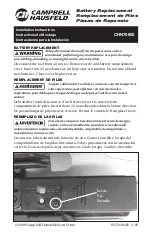
GENERAL & SPECIFIC
SAFETY INSTRUCTIONS
1. KNOW YOUR TOOL
Read and understand the owners manual and labels affixed to the
tool. Learn its application and limitations as well as its specific
potential hazards.
2. KEEP WORK AREA CLEAN.
Cluttered areas and benches invite accidents. Make sure the floor
is clean and not slippery due to wax and sawdust build-up.
3. AVOID DANGEROUS ENVIRONMENT.
Don’t use power tools in damp or wet locations or expose them to
rain. Keep work area well lit and provide adequate surrounding work
space.
4. KEEP CHILDREN AWAY.
All visitors should be kept a safe distance from work area.
5. USE RIGHT TOOL.
Don’t force the tool or the attachment to do a job for which it was
not designed.
6. WEAR PROPER APPAREL.
Do not wear loose clothing, gloves, neckties or jewelry (rings,
watch) because they could get caught in moving parts. Non-slip
footwear is recommended. Wear protective hair covering to contain
long hair. Roll up long sleeves above the elbows.
7. ALWAYS WEAR SAFETY GLASSES.
Always wear safety glasses (ANSI Z87.1). Everyday eyeglasses
only have impact resistant lenses, they are
NOT
safety glasses.
8. DON’T OVERREACH.
Keep proper footing and balance at all times.
9. MAINTAIN TOOL WITH CARE.
Keep tools sharp and clean for best and safest performance. Follow
instructions for lubricating and changing accessories.
10. DISCONNECT TOOLS.
Before servicing, when changing accessories or attachments.
11. USE RECOMMENDED ACCESSORIES.
Consult the manual for recommended accessories. Follow the
instructions that accompany the accessories. The use of
improper accessories may cause hazards.
12. CHECK DAMAGED PARTS.
Before further use of the tool, a guard or other parts that are
damaged should be carefully checked to ensure that they will
operate properly and perform their intended function. Check for
alignment of moving parts, breakage of parts, mounting, and any
other conditions that may affect its operation. A guard or other
parts that are damaged should be properly repaired or replaced.
Read and understand tool labels and all of the operating
instructions, safety and warnings in this manual before operating
or maintaining this nailer. Failure to follow warning could result in
death or serious injury.
This nailer is powered by internal combustion device (fuel cell). This
nailer shall only be used with dispensers of combustible gas which are
listed in this instruction manual.
1. OPERATOR MUST WEAR SAFETY GLASSES WITH SIDE
SHIELDS.
When operating the nailer, always wear safety glasses with side
shields, and make sure other in work area wear safety glasses too.
2. NEVER USE IN PRESENCE OF FLAMMABLE LIQUIDS OR
GASES.
This nailer must not be used in a combustible environment or in the
presence of flammable liquids or gases, e.g. lacquer, paint,
benzine, thinner or gasoline.
This nailer produces hot exhaust
gases that may ignite flammable materials and produces
sparks during operation.
3. DO NOT TOUCH AROUND THE EXHAUST OUTLET.
This nailer produces hot exhaust gases that may ignite materials.
The push lever and nose will become hot and get heated up after
prolonged or rapid use. Do not touch with bare hands.
4. EXPLOSION AND FIRE HAZARD.
The fuel cell is an aerosol dispenser with flammable contents. Keep
the nailer, fuel cells and battery away from sunshine and from
temperature exceeding 50°C (120°F). Fuel cell and/or battery may
burst, releasing flammable gas. Do not pierce or burn the
container, even after use. Do not incinerate, refill, reclaim or
recycle the fuel cell. Do not spray on a naked flame or any
incandescent material. Keep away from ignition sources - no
smoking. Keep out of reach of children.
5. NEVER POINT TOOL AT YOURSELF OR OTHERS.
Always assume the nailer contains fasteners. Never point the nailer
at yourself or others, whether it contains fasteners or not. If
fasteners are mistakenly driven, it can lead to severe injuries.
continued on following page.....
SPECIFIC SAFETY INSTRUCTIONS FOR CORDLESS GAS FRAMING NAILER





























